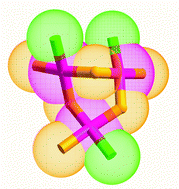The reaction of the primary phosphane (ferrocenylmethyl)phosphane [PH2CH2Fc, 1] with an equimolar amount of [M(cod)Cl2] (cod = 1,5-cyclooctadiene, M = Pd, Pt) gave the unusual monobridged M(II) dinuclear complexes of formula [(cod)ClM(μ-PHCH2Fc)M(PH2CH2Fc)Cl2] [M = Pt, 2; M = Pd, 3]. The mechanism leading to 2 and 3 involves the preliminary formation of cis-[M(PH2CH2Fc)2Cl2] which further reacts with free [M(cod)Cl2] before undergoing dehydrochlorination. The reaction of 3 with PPh3 led to the unexpected formation of the cyclic trinuclear complex [Pd3(μ-PHCH2Fc)3(PPh3)2(PH2CH2Fc)Cl3] (5). Further reaction of 5 with PPh3 led to the substitution of the tertiary phosphane for the primary one with formation of two geometric isomers 4a and 4b of formula [Pd(μ-PHCH2Fc)(PPh3)Cl]3 differing only for the position of the PPh3 group replacing the PH2CH2Fc ligand. In complex 4b each μ-PHCH2Fc group bridging two palladium atoms has a terminal PPh3 ligand in trans position with respect to the first Pd (the cis position being occupied by a chlorine) and a chlorine ligand trans to the other Pd (the cis position being occupied by a terminal PPh3 ligand) thus rendering chemically equivalent the three PPh3 (and the three phosphides). In complex 4a the three terminal PPh3 as well as the three bridging phosphido ligands are chemically inequivalent. Complexes 4a and 4b coexist in equilibrium in solution, but only 4a precipitates from CH2Cl2–n-hexane yielding crystals suitable for X-ray analyses. These crystals are water/n-hexane solvates and belong to the monoclinic space P21/c with a = 25.063(6) Å, b = 15.564(4) Å, c = 26.089(5) Å, β = 120.017(16)°. They contain two identical couples of enantiomers of 4a. The peculiar arrangement of three metals and three phosphorus atoms of the bridging ligands ascertained for trimers 4a, 4b and 5 has no precedent in the rich class of palladium and platinum phosphido chemistry.

You have access to this article
 Please wait while we load your content...
Something went wrong. Try again?
Please wait while we load your content...
Something went wrong. Try again?


 Please wait while we load your content...
Please wait while we load your content...